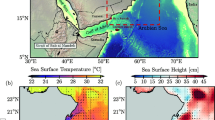Abstract
Properties of coastal trapped waves when the pycnocline intersects a sloping bottom are studied using a two-layer model which has slopes in both layers. In this system there is an infinite discrete sequence of modes, and four different sorts of waves exist: the barotropic Kelvin wave, the upper shelf wave, the lower shelf wave and the internal Kelvin-type wave. They all propagate with the coast to their right in the Northern Hemisphere. The upper and lower shelf waves are due to the topographicβ-effect on the upper-layer and lower-layer slopes, respectively. Their motions are dominant in the respective layers being accompanied by significant interface elevations. The properties of the upper (lower) shelf wave are almost unaffected by the existence of a lower-layer (upper-layer) slope. The motion of the internal Kelvin-type wave is confined to the region around the line where the density interface intersects the bottom slope.
The modes, except that with the fastest phase speed (the barotropic Kelvin wave), are assigned mode numbers in order of descending frequency. Characteristics of Mode 1 change with wavenumber; the upper shelf wave for small wavenumbers and the internal Kelvin-type wave for large wavenumbers (high frequencies). The higher modes of Mode 2 and above can be classified into the upper and lower shelf waves.
Similar content being viewed by others
References
Allen, J. S. (1975): Coastal trapped waves in a stratified ocean. J. Phys. Oceanogr.,5, 300–325.
Huthnance, J. M. (1978): On coastal trapped waves: Analysis and numerical calculation by inverse iteration. J. Phys. Oceanogr.,8, 74–92.
Kajiura, K. (1974): Effect of stratification on long period trapped waves on the shelf. J. Oceanogr. Soc. Japan,30, 271–281.
Kawabe, M. (1982): Branching of the Tsushima Current in the Japan Sea, Part II. Numerical experiment. J. Oceanogr. Soc. Japan,38(4), in press.
Suginohara, N. (1982): Coastal upwelling: Onshoreoffshore circulation, equatorward coastal jet and poleward undercurrent over a continental shelfslope. J. Phys. Oceanogr.,12, 272–284.
Wang, D. P. (1975): Coastal trapped waves in a baroclinic ocean. J. Phys. Oceanogr.,5, 326–333.
Wang, D. P. andC. N. K. Mooers (1976): Coastal-trapped waves in a continuously stratified ocean. J. Phys. Oceanogr.,6, 853–863.
Author information
Authors and Affiliations
Rights and permissions
About this article
Cite this article
Kawabe, M. Coastal trapped waves in a two-layer ocean: Wave properties when the density interface intersects a sloping bottom. Journal of the Oceanographical Society of Japan 38, 115–124 (1982). https://doi.org/10.1007/BF02110282
Received:
Revised:
Accepted:
Issue Date:
DOI: https://doi.org/10.1007/BF02110282




